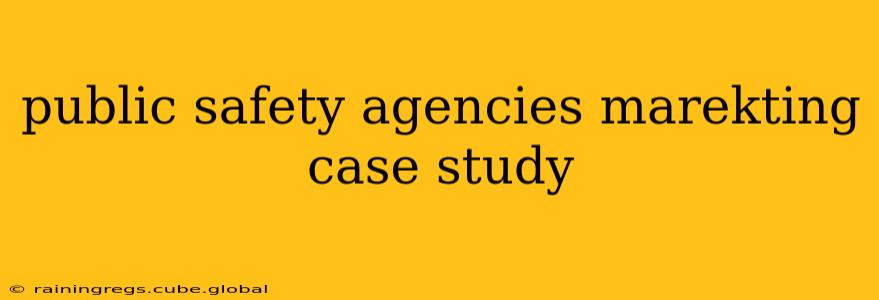Public safety agencies face a unique challenge: marketing life-saving information without resorting to fear-mongering or appearing alarmist. Effective marketing for these organizations requires a delicate balance of educating the public, building trust, and promoting preparedness. This case study explores successful strategies and analyzes key elements for impactful public safety marketing campaigns. We'll examine real-world examples and offer actionable insights for agencies looking to enhance their community outreach.
The Challenges of Marketing Public Safety
Marketing for public safety agencies differs significantly from commercial marketing. Instead of focusing on sales, the primary goal is behavior change. This requires a nuanced approach that considers the emotional and psychological aspects of risk communication. Some key challenges include:
- Building Trust: Citizens need to trust the information provided by public safety agencies. A history of transparency and consistent communication is crucial.
- Reaching Diverse Audiences: Effective messaging needs to resonate with diverse communities, considering language barriers, cultural nuances, and varying levels of digital literacy.
- Maintaining Relevance: Public safety messaging needs to be timely and relevant, adapting to emerging threats and community needs.
- Avoiding Alarmist Messaging: Fear-mongering can be counterproductive, leading to apathy or distrust. Positive and empowering messages are more effective.
- Measuring Effectiveness: Demonstrating the ROI of public safety campaigns can be challenging, requiring creative metrics beyond simple engagement numbers.
Successful Strategies: Case Studies and Examples
Several agencies have successfully implemented innovative marketing strategies to enhance public safety. These examples highlight best practices and offer valuable lessons:
Example 1: Community-Based Policing Initiatives
Many police departments are moving towards community-based policing, leveraging social media to build relationships and foster trust. This involves sharing positive stories, engaging with community members, and proactively responding to concerns. Successful implementations use targeted social media campaigns, regular town hall meetings, and partnerships with community leaders.
Example 2: Emergency Preparedness Campaigns
Effective emergency preparedness campaigns use a multi-channel approach, combining social media, traditional media, and community events. These campaigns often focus on specific scenarios (e.g., hurricane preparedness, wildfire safety) and provide clear, actionable steps for individuals and families. Successful campaigns rely on clear, concise messaging, visually appealing graphics, and easily accessible resources.
Example 3: Crime Prevention Through Environmental Design (CPTED)
CPTED uses environmental design principles to reduce crime opportunities. Marketing efforts in this area focus on educating community members about the importance of proper lighting, landscaping, and security measures. Agencies might utilize infographics, videos, and workshops to promote CPTED principles.
Example 4: Utilizing Data and Analytics
Advanced analytics can help target messaging and resource allocation. By analyzing crime data and community demographics, agencies can create more effective campaigns tailored to specific needs.
Frequently Asked Questions (FAQs)
Here are some common questions about marketing for public safety agencies:
How can public safety agencies measure the success of their marketing campaigns?
Measuring success requires a multifaceted approach. This includes tracking website traffic, social media engagement, survey data, and changes in reported incidents or community behavior. Qualitative data, such as feedback from community members, is equally important.
What role do social media play in public safety marketing?
Social media provides a powerful tool for real-time communication, community engagement, and rapid dissemination of critical information. However, it's crucial to maintain a professional and consistent presence, addressing comments and concerns promptly.
How can public safety agencies overcome language barriers in their marketing efforts?
Translating materials into multiple languages is essential for reaching diverse communities. Agencies should also consider using culturally relevant imagery and messaging to ensure effective communication.
What are some examples of successful public safety marketing campaigns?
Many successful campaigns focus on clear, concise messaging, engaging visuals, and a multi-channel approach. Look to agencies that utilize data-driven insights and actively measure campaign effectiveness.
How can public safety agencies build trust with the community?
Trust is built over time through transparency, consistency, and responsiveness. Agencies should actively solicit feedback, address concerns openly, and demonstrate a commitment to community well-being.
Conclusion: Building Stronger Communities Through Effective Communication
Marketing for public safety is about more than just disseminating information; it's about building relationships, fostering trust, and empowering communities to protect themselves. By leveraging innovative strategies, focusing on clear and concise messaging, and actively engaging with the public, agencies can significantly improve public safety and create stronger, more resilient communities. Continuous evaluation and adaptation are crucial for maintaining relevance and maximizing impact.
